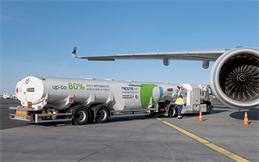
The International Air Transport Association (IATA) has announced that its projections for tripling Sustainable Aviation Fuel (SAF) production in 2024 to 1.9 billion liters (1.5 million tonnes) are on track. This would account for 0.53% of aviation's fuel needs in 2024.
To accelerate SAF use, IATA said there are several policy measures that governments could take.
SAF will provide about 65% of the mitigation needed for airlines to achieve net zero carbon emissions by 2050.
"So the expected tripling of SAF production in 2024 from 2023 is encouraging," said Willie Walsh, director-general at IATA.
"We still have a long way to go, but the direction of exponential increases is starting to come into focus," he added.
Many industries share the production of renewable fuels, and SAF is part of this production. That is why, IATA noted that increasing the production of renewable fuel is key to increasing the potential of SAF.
It added that some 140 renewable fuel projects with the capability to produce SAF have been announced to be in production by 2030.
"If all of these proceed to production as announced, total renewable fuel production capacity could reach 51 million tonnes by 2030, with production capacity spread across almost all regions," IATA said.
Renewable fuel production potential could exceed this estimate as investor interest in SAF grows.
With a typical three-to-five-year time lag from planning to production, investment announcements as late as 2027 could be in production by 2030.
At the same time, IATA noted that it is also clear that not all announcements reach final investment decisions.
IATA said through the International Civil Aviation Organization (ICAO), governments set an ambition to achieve a 5% CO2 emissions reduction for international aviation from SAF by 2030.
To achieve that ambition, around 27% of all expected renewable fuel production capacity available in 2030 would need to be SAF.
Currently, SAF accounts for just 3% of all renewable fuel production.
"The interest in SAF is growing, and there is plenty of potential. But the concrete plans that we have seen so far are far from sufficient," Walsh said.
"Governments have set clear expectations for aviation to achieve a 5% CO2 emissions reduction through SAF by 2030 and to be net zero carbon emissions by 2050. They now need to implement policies to ensure that airlines can actually purchase SAF in the required quantities," he added.
Policy measures to boost SAF production
IATA noted that several potential solutions exist to accelerate aviation's access to critical SAF quantities, including diversifying feedstocks and co-processing, where existing refineries can be used to co-process up to 5% of approved renewable feedstocks alongside the crude oil streams.
It added that incentives to improve the output mix at renewable fuel facilities could also be looked at.
"The current renewable fuel facilities are designed to maximize diesel production and often benefit from incentives in addition to the long-standing demand from road transportation. As road transport transitions to electrification, policies should be established to shift production toward the long-term need of air transport for SAF," the IATA statement said.
"Incentives aimed at SAF can help facilitate the renewable diesel-SAF switch, which requires minimal modifications at existing stand-alone renewable fuel facilities," it added.
Governments could also look into incentives to boost investments in renewable fuel production, and incentives to build more renewable energy facilities, strengthen the feedstock supply chain, and allocate a greater portion of renewable fuel output to aviation, which would help decarbonise aviation.
"Governments can also facilitate technical solutions with accelerated approvals for diverse feedstocks and production methodologies as well as co-processing renewable feedstocks in crude oil plants," Walsh said.
"No one policy or strategy will get us to the needed levels. But by using a combination of all potential policy measures, producing sufficient quantities of SAF is absolutely possible," he added.



